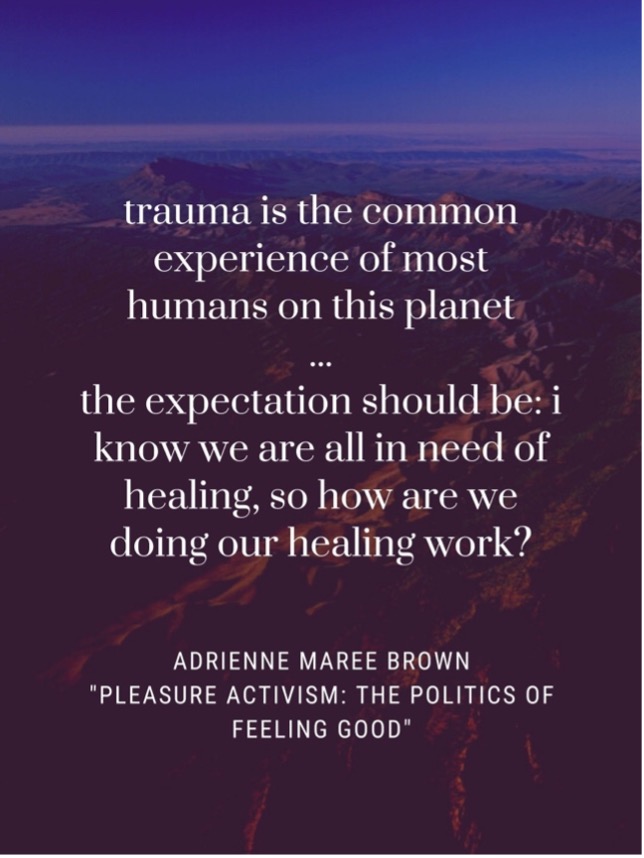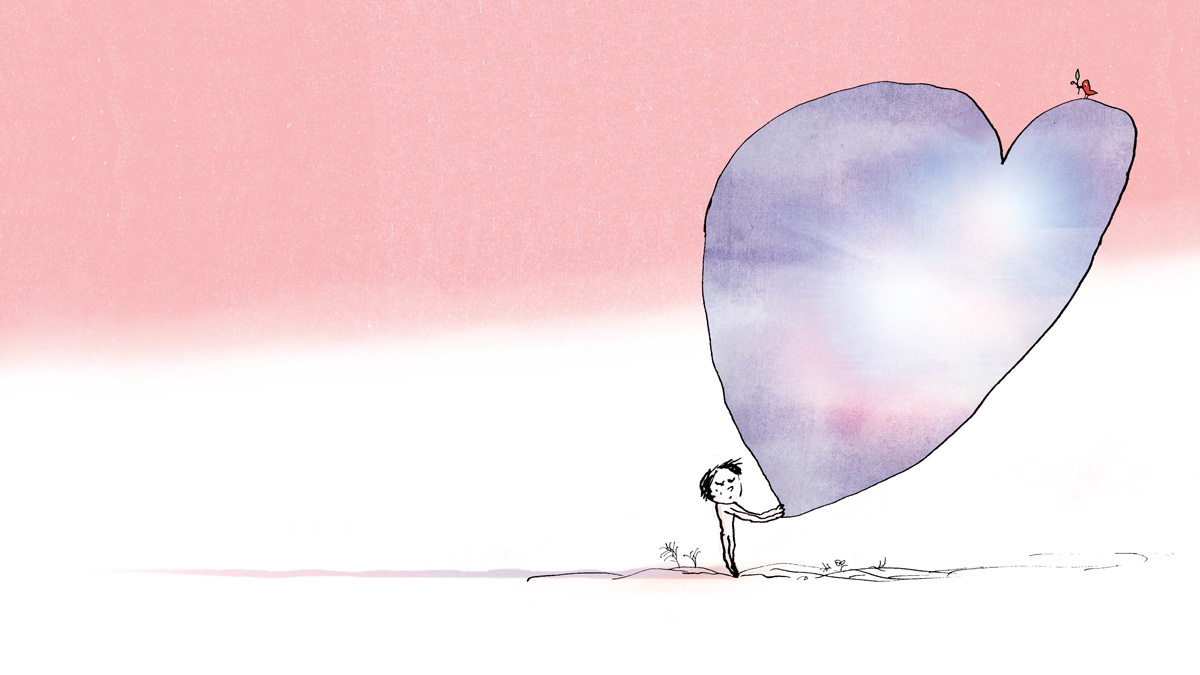By Miranda Fedock
This post is about trauma: what it is, how it shows up in our teaching and learning spaces at CUNY, and what we can do about it. As CUNY educators, it is our job to understand how trauma affects us and our students and colleagues, and to do what we can to design our courses as safe, inclusive spaces that promote emotional resilience. Because I am not an expert on trauma, I can only speak from my personal experience. But personal experience is a key lens for understanding trauma, for beginning to grasp what can seem ungraspable, for making present that which feels distant. So this first-person writing shares a little of my journey, in hopes that some of it will be helpful to you.
Trauma can feel like a big, scary topic. So before we begin, I invite you to take a few moments to yourself. Breathe deeply – if you like, follow along with this animation for a few breaths. Now, to whatever extent you’re comfortable doing so, focus your attention onto your thoughts, body and/or emotions. First, just notice what you’re thinking and feeling, without judgment. Then, ask yourself: when you see the word “trauma,” what do you think of? What happens in your body? What feelings rise to the surface? Know that whatever answers you arrive at are valid and okay, even if they don’t make sense to you right now. Feel free to write down your answers, and perhaps to spend a few minutes journaling about them.
Until early 2020, when I saw the word “trauma” I thought of something frightening and distant, something terrible that happens to people in faraway places. The term felt big, intimidating, and largely irrelevant to me and my community; I tried not to think about it (maybe this is the case for you too). Then I started therapy, and quickly learned that the intense anxiety I’ve dealt with for most of my life is actually a symptom of experiencing trauma throughout my youth. I also learned that trauma is actually quite common, affecting around seventy percent of US adults and slightly more US college students (Carello and Butler 2015, 263; Tea for Teaching 2020), and its definition is more inclusive than most realize: trauma simply refers to a negative experience that overwhelms a person’s ability to cope and that negatively affects their functioning afterwards, often persistently (SAMHSA 2019; Craig 2017, 16).
In March 2020, the pandemic hit New York City, everything changed for everyone, and suddenly articles about widespread collective trauma were popping up all over my news apps and social media. The past year kept throwing potentially traumatizing events our way: COVID deaths, murders of Black folx, job losses, budget cuts, white supremacist attacks, white supremacist policies, a toxic election, an attempted coup, lockdowns, more lockdowns, all the lockdowns, and, and, and. Meanwhile, I continued working to heal my personal trauma, and heard snippets of wisdom gleaned from my therapist and other healers echoed in public discourse – “grieve what you lost,” “take care of yourself,” “reach out to your community,” “focus on what you can control and accept what you can’t.”
At the same time, I Zoomed with my students, and quickly realized how wildly unprepared I was to support them as they melted into tears, or froze with fear, or shook with rage, as they fed their families and risked exposure at their essential jobs and navigated broken health insurance bureaucracies and grieved their lost loved ones and watched people who looked like them get shot in the streets, all while trying to stay in school and keep up with their classes, many of which now had more demanding workloads than pre-pandemic. The year’s dangers were disproportionately targeting them, and I felt helpless to do anything about it. So when I began my fellowship at the TLC in Fall 2020, I decided to spend some of my time in the position learning about trauma-informed pedagogy, in order to figure out how to better serve and support my students, and myself, in the face of trauma.
What I learned changed how I teach and work.

Art by Lia Halloran from Black Hole Survival Guide by Janna Levin. https://www.brainpickings.org/2020/12/19/favorite-books-2020/
What I learned is that trauma seriously negatively affects our ability to learn. If you have lived through trauma, you already know this. I already knew it, too – I have lived this truth for nearly my whole life as a student. Literature on trauma-informed pedagogy gives me biological facts to back up and explain my lived experiences. Why does it feel impossible to study when I feel triggered or scared? Because my brain automatically goes into its fight-flight-freeze response when I get triggered, and when in that mode, the prefrontal cortex, the area of the brain responsible for learning and executive functioning, shuts down (Carello 2020). Why have I always seemed to have more trouble than my classmates processing or recalling new information? Because I lived through childhood trauma, which affects the development of the hippocampus, left cerebral cortex, and cerebellar vermis, making it harder for the brain to integrate sensory information (Craig 2017, 22).
This literature also helps explain what my students were, and are, going through. Since March 2020, some of my students have gone through periods of intense emotional volatility, reacting with strong anxiety or anger to minor technical errors, inconveniences, or constructive feedback. I’ve had to repeat myself to my students much more than usual, and they often seem to have trouble taking in new information and submitting work on time. They tell me that they can’t focus, can’t sleep, can’t stay awake, can’t remember things, can’t find the motivation to get work done (I relate to much of this. You might, too). Turns out that all of these behaviors can be symptoms of trauma (Davidson). Turns out that trauma creates serious barriers to learning.
Like a broken leg, trauma is a physical injury, requiring time, patience, and a healing plan. We wouldn’t ask someone with a broken leg to exercise like they did before the injury. Likewise, we can’t ask a student with trauma to learn as if they had no trauma.
Think of a few ways the traumatic events of 2020 might be affecting your and your students’ capacities to learn. What changes have you noticed in your students now, compared to your students pre-2020? What changes have you noticed in yourself, in relation to your research and learning? Which of these might be related to trauma responses? Be kind to yourself and your students as you gently explore this topic.
The traumatic experiences in my life affecting how I teach and learn long predate 2020, however. This is true for many CUNY students, who are also likely to be dealing with trauma that I as a white person with other privileged identities am not. Higher education can be traumatizing for anyone, but there is particularly high potential for trauma at CUNY, where the majority of undergraduates are students of color, immigrants, and/or students with other marginalized identities. Institutional racism, sexism, colorism, classism, colonial practices, anti-immigrant practices, carceral logics, lack of representation, lack of funding–our students learn in an institution and in classrooms fundamentally shaped by these traumatizing realities. Systemic changes are needed in higher education, and in our society at large to put an end to such chronic trauma, and we must work towards making those changes happen. In addition, we can help create spaces of care and healing at CUNY by recognizing trauma and by doing what we can to prevent further harm.

Image created by author using Canva.
There are things we can do, as educators, to create learning environments that prevent traumatizing or triggering our students, and that promote emotional safety and resilience. I learned this from reading about trauma-informed pedagogy, in conversation with my friends and colleagues at the TLC, and in my experiences as a student at various institutions for most of my life. Here are twelve strategies that I’m trying out right now to help promote safety and healing among my students. You might try these out, too.
- Be predictable and consistent whenever possible. Offer your students structure. Students feel safer when they know what to expect in your class. Some ways you can do this include developing class routines, articulating clear policies that you implement consistently, and sharing class agendas with students. For more on how habits, routines, and rituals can build community in a class, see Chy Sprauve’s post.
- Allow for and model flexibility whenever needed. When possible, allow students to turn in work late without penalty and without needing an excuse. Here are two ways you could structure this while respecting your own time and limits: give students a number of “late day” tickets that they can turn in for extra time; schedule a “makeup day” towards the end of the semester when students can turn in late work.
- Provide a limited number of choices. Offering choices to students empowers them to take control of certain elements of their learning, emphasizes their strengths, and builds their confidence. Proposing only a few options helps prevent students from becoming confused or overwhelmed, as is likely when they are faced with too many choices. Choices might include assignment or activity type, format, or topic; ways to participate in class; assessment method; which readings to do or what to focus on in the readings. Always give students the choice not to engage with difficult material, without their having to explain why.
- Use non-coercive and compassionate language. Reliably give positive feedback (even just “good job, you tried”). Use “I” statements (for example, “I feel x because of y,” “I have trouble understanding x,” “From my perspective, it seems that x”). Replace words like “should, must, require” with “invite, encourage, welcome.” Avoid defensive or scolding language.
- Explicitly address mental and emotional wellbeing in your class. Have regular check-ins with student and create informal spaces for them to check in with each other. You might start classes with a short deep breathing exercise (here’s a good brief one). Compile a living list of self-and communal-care practices with students. Include a statement in your syllabus about the importance of mental and emotional health, perhaps in conjunction with your campus’ wellness resources.
- Create safe spaces for students to make mistakes. Give plenty of no-stakes and low-stakes assignments, activities, and assessments. Allow multiple attempts, drafts, and revisions. Reward student successes rather than punishing failures.
- Provide plenty of opportunities for students to give feedback to you and each other. Build in student feedback throughout the course and take it seriously. If students share that they are overwhelmed by the amount of work you’re giving them, think about how you can lessen their workload while still achieving your course’s learning goals. Facilitate peer feedback among students on various assignments. This tells students their voices matter and helps them build positive relationships with their peers.
- Acknowledge and validate students’ emotions. If your student is feeling something uncomfortable (such as anxiety or anger), statements like this go a long way: “I hear you,” “I understand,” “it sounds like you’re feeling x,” “when z happens it can make us feel x,” “it’s okay to feel how you’re feeling.” Put a name to the student’s feeling, normalize it, and grant permission for them to feel that way. These simple words help the student feel seen and accepted for who they are, establish trust between you and the student, and strengthen the student’s emotional intelligence. Such acknowledgement and validation has deep healing potential.
- Be honest and transparent as much as possible, which helps students learn to trust you, and communicates your respect for them. If a student is questioning a class policy that you’re not willing to change, avoid defending it with the “because I said so” argument. Instead, be honest with them about your reasons for using that policy and why you will not change it. Relatedly, model vulnerability, to whatever extent you’re comfortable doing so. For example, if you’re late with grades because you’re dealing with a personal crisis or having a bad anxiety day, tell your students that. This tells students it’s okay to be imperfect and it’s normal to experience difficult emotions. Be clear with yourself about your own boundaries: only share as much as you’re comfortable sharing, and never feel obligated to share anything you would rather not.
- Know and honor your personal and professional boundaries and limitations. Making these clear helps you and helps your students feel safe, because they know what to expect from you and what your rules of interaction are. For example, write on your syllabus when you will and won’t answer emails and how long it will take you to respond. Do not offer counseling if you’re not a counselor.
- Refer students to resources, like your campus’ wellness center, and intentionally show students how to use them. Make using these resources approachable by offering to facilitate initial contact (but don’t insist), or modeling help-seeking behavior by telling students when you used one of these resources yourself.
- Take care of yourself. Develop self-care plans and use them often. Learn to recognize and tend to symptoms of compassion fatigue in yourself, as you would a physical wound. Remember you don’t have to be perfect.
Will doing these things wholly and instantly heal your students’ traumas, or prevent them from becoming triggered 100% of the time? No: neither of those outcomes are your job or responsibility, nor are they within any single person’s capacity to accomplish. And that’s okay. Trying out some of these strategies will help you and your students feel safer in your class, build their emotional resilience, and avoid further traumatization. For more strategies and practices, check the resources listed below.
I’m writing this in March 2021. Overall, my students seem to be feeling a bit more stable, confident, and capable this semester, probably in part due to the slowly improving conditions of some areas of some of their lives: hope on the horizon that the pandemic may one day end, a heartening if insufficient change in political regime, fewer COVID deaths. I’m intentionally including trauma-informed practices in my teaching, and those seem to be helping, too. Last week, I asked students to do a short mindful breathing exercise on their own. Afterwards, nearly all the students told me that they were able to complete the rest of their schoolwork that week with more clarity, better focus, and less anxiety than usual. In turn, being gentler with my students has taught me to be gentler with myself. I am imperfect, and that is okay. I am healing from trauma, and that is okay too. We all are. Let’s name that, and heal together.

Art by Pascal Lemaître, from Listen by Holly M. McGhee. https://www.brainpickings.org/2019/09/19/listen-holly-mcghee-pascal-lemaitre/
Miranda Fedock is a PhD candidate in ethnomusicology and a Fellow at the TLC. She teaches music at City College.
References
Carello, Janice. 2020. Trauma-Informed Teaching & Learning in Times of Crisis. Youtube.
Carello, Janice, and Lisa Butler. 2015. “Practicing What We Teach: Trauma-Informed Educational Practice.” Journal of Teaching in Social Work 35 (May): 262–78.
Craig, Susan E. 2017. Trauma-Sensitive Schools for the Adolescent Years: Promoting Resiliency and Healing, Grades 6–12. Teachers College Press.
Davidson, Shannon. n.d. “Trauma-Informed Practices for Postsecondary Education: A Guide.” Education Northwest.
SAMHSA. 2019. “Trauma and Violence.” Accessed March 24, 2021.
Tea for Teaching. 2020. “Trauma-Informed Pedagogy.” Tea for Teaching. Accessed September 2, 2020.
Additional Resources
Carello, Janice. n.d. Trauma Informed Teaching and Learning: Bringing a Trauma-Informed Approach to Higher Education. Blog. Accessed March 26, 2021. https://traumainformedteaching.blog
Fedock, Miranda. 2021. “Mental and Emotional Wellbeing in 2021: Strategies and Practices for All Educators.” Google Slides. Teaching and Learning Center, CUNY Graduate Center.
Imad, Mays. n.d. “Trauma-Informed Pedagogy.” Video, 57:48.
Phelps-Ward, Robin. 2020. “Pedagogical Strategies for Inclusive and Trauma-Informed Teaching.” Blog post for Southern Regional Education Board. October 8, 2020.










Leave a Reply